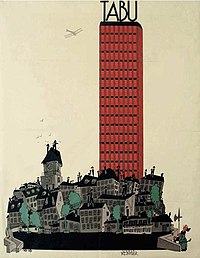Julius Klinger
You can help expand this article with text translated from the corresponding article in German. (December 2009) Click [show] for important translation instructions.
|
This article needs additional citations for verification. (May 2009) |
Julius Klinger (22 May 1876 – 1942) was an Austrian painter, draftsman, illustrator, commercial graphic artist, typographer and writer. Klinger studied at the Technologisches Gewerbemuseum in Vienna.[1]
Early works in Vienna and Munich
[edit]
Klinger was born in Dornbach near Vienna. In 1895, he found his first employment with the Vienna fashion magazine Wiener Mode. Here he made acquaintance with Koloman Moser, who later would be his teacher; Moser recommended him to the Meggendorfer-Blätter.[2]
1896 saw him moving to Munich where he worked as an illustrator for the Meggendorfer-Blätter[3] and others. From 1897 to 1902 he was a collaborator to the eponymous Jugendstil magazine Die Jugend.
Berlin
[edit]
In 1897 he relocated to Berlin, where he worked extensively as a commercial graphic artist until 1915. Together with the printing house Hollerbaum und Schmidt, he developed a new fashion of functional poster design that soon gained him international reputation.[2] In 1912 he designed the poster for the Rund um Berlin air show in Johannisthal. In Berlin he also contributed to Das kleine Witzblatt, Lustige Blätter and Das Narrenschiff humorous magazines.
Advertising campaign for the "Tabu" company
[edit]
Beginning in 1918, Klinger designed a comprehensive and noted campaign promoting the "Tabu" company's cigarette rolling paper, that was advertised all over Vienna in 1918/19. Klinger devised a promotional strategy, spanning from small-sized newspaper advertisements to billboards and painted firewalls – construction site fences and winterized fountain paneling were used as advertising space, too.[4]
Nazi persecution
[edit]Klinger was persecuted by the National Socialists because he was Jewish. According to Viennese police records, he and his wife Emilie were registered as "Moved to Minsk" on 2 June 1942. This designation was synonymous during the Nazi era with deportation. Large numbers of Viennese Jews were murdered at the Maly Trostenets extermination camp near Minsk. It is presumed that Julius and Emilie suffered this fate in 1942 or soon after.
Klinger's final poster was designed towards the end of 1937 for the Ankerbrot-Werke factory. The Jewish-owned company was transferred to "Aryan" proprietors in 1938; after 1945 legitimate ownership was restored.
In 1982, Klingerstraße in Vienna-Liesing was named after him.

Literature
[edit]- Anita Kühnel: Julius Klinger – Bilderheft der Staatlichen Museen zu Berlin (Catalogue of the Berlin State Museums), Gebr. Mann, Berlin, 1999
Gallery
[edit]-
Ad for "Tabu" cigarette paper (1919)
-
Poster for 8e war loan, Austria-Hungary (1918)
-
Berlin Johannisthal Airport (1908)
-
Ties Hermanns & Froitzheim (1911)
-
Poster for "Tabu" cigarette paper (1919)
-
Poster for "Elida" toilet soap (1921)
-
Vienna International Fair (1922)
-
"MEM" (M. E. Mayer, Vienna) razor blades (1922)
-
Poster of the Viennese perfume company Pessl (1923)
External links
[edit] Media related to Julius Klinger at Wikimedia Commons
Media related to Julius Klinger at Wikimedia Commons- Dr.Wiles-Worris – Weil's woah is, Der Standard, 12. November 1999
- Anita Kühnel: Julius Klinger – Poster Artist and Draftsman
Notes
[edit]- ^ Austrian AEIOU Encyclopedia
- ^ a b Julius Klinger (Wien 22. 5. 1976-1942?) Archived 2008-09-18 at the Wayback Machine, biographical entry with the Austrian National Library
- ^ David Ciarlo (2011). Advertising Empire. Cambridge, MA; London: Harvard University Press. p. 292. ISBN 978-0-674-05006-8.
- ^ Plakat: Julius Klinger: Tabu, 1919 Archived 2004-08-23 at the Wayback Machine, Austrian National Library, 2003
- 19th-century Austrian painters
- 19th-century Austrian male artists
- Austrian male painters
- 20th-century Austrian painters
- Austrian illustrators
- Austrian male writers
- Austrian graphic artists
- Austrian typographers and type designers
- Austrian Jews
- People from Hernals
- Austrian poster artists
- Austrian Jews who died in the Holocaust
- 1876 births
- 1942 deaths
- Jewish Austrian artists
- 20th-century Austrian male artists









